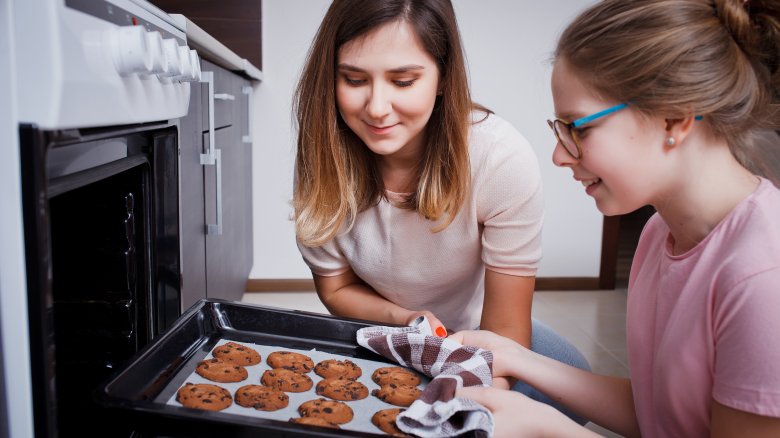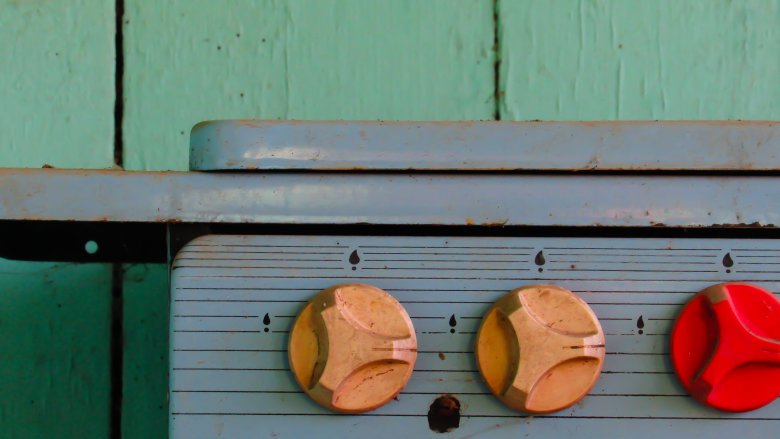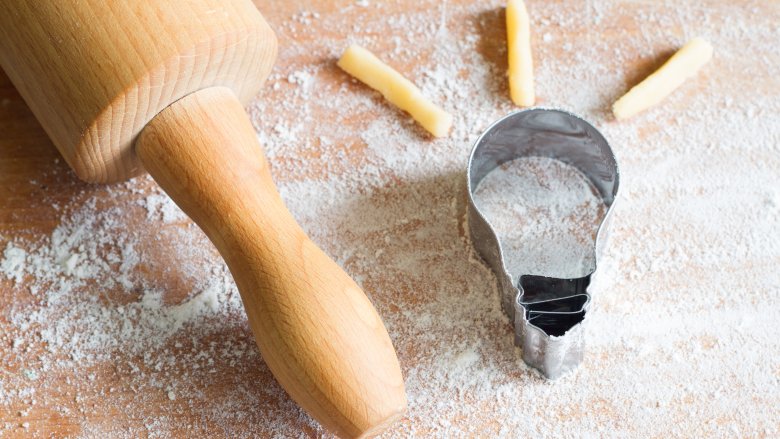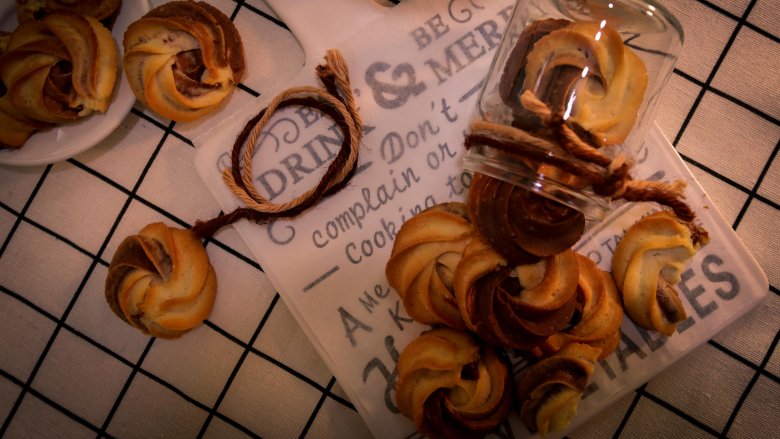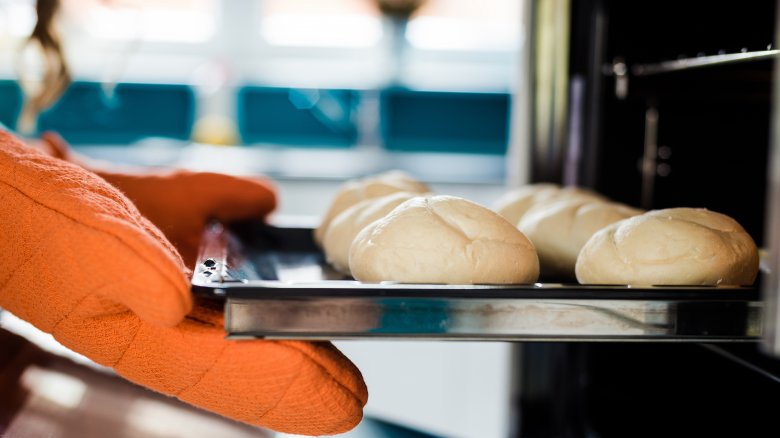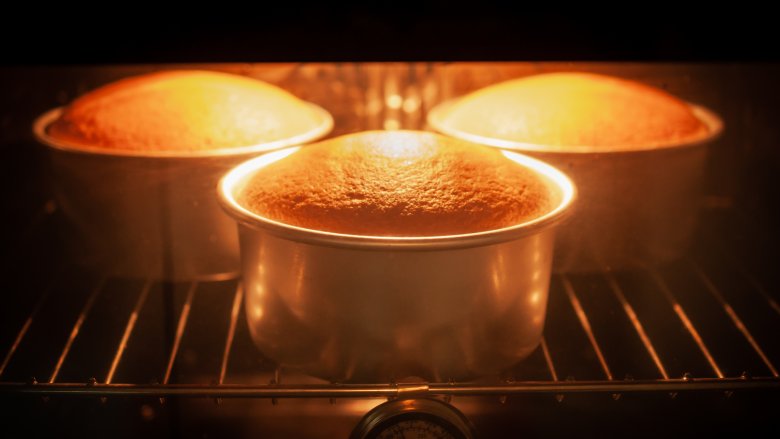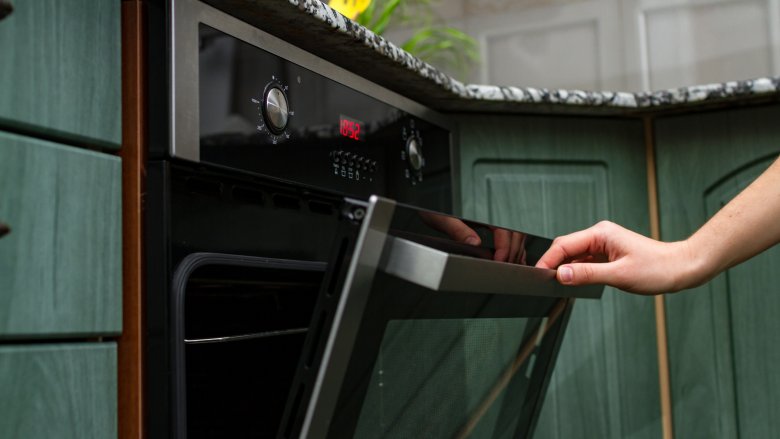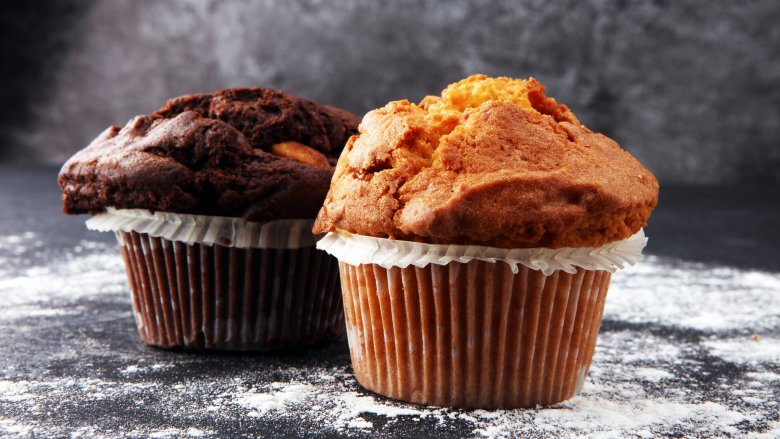Why We Bake Everything At 350 Degrees
We all know those cooks that have that innate ability to sort of just throw a ton of stuff together and have it come out amazing. They're the ones that need no recipe, and sometimes, they don't even need a vague idea of what they want the final dish to taste like. Cooking can evolve organically, but baking is something entirely different.
Baking is a science, and getting the final product you're looking for requires careful execution of a recipe — and sometimes, even then, it doesn't come out entirely right. That's because there are a ton of scientific principles that come into play, and it's pretty much chemistry you can actually eat.
A large part of that science has to do with the temperature you bake things at, and you've probably noticed that a lot of recipes for things like cookies and cakes all seem to call for the same temperature: 350 degrees Fahrenheit. It doesn't matter if it's banana bread or chocolate chip cookies... and that seems a bit weird. You'd think there would be some variation there, so why 350? It's not actually arbitrary, and the reasons why are an interesting mixture of science and history.
It's a default from long ago
Mankind has been baking for a long, long time, and it was only at the end of World War II that ovens started to come with exact temperature controls. In the few decades before that, ovens tended to come with only three options for temperature: slow, moderate, and hot.
If you happened to dig out any of your grandmother's or great-grandmother's cookie recipes, you might be baffled by the bit that calls for baking them in a "moderate" oven. It seems archaic today, but it was a huge step forward over how Victorian-era bakers judged whether or not their ovens were hot enough, Slate says. They estimated oven temperature by sprinkling the bottom of the oven with flour. If it didn't catch fire and only started to blacken, then it was perfect.
Over the years, recipes have changed along with the technology we use to cook them. Old terminology was updated to new technology, and when recipes that called for a "moderate" oven were updated, the temperature was just estimated to be 350. (A temperature which, incidentally, is usually in the middle of most oven dials.)
The temperature matters, but it's hard to be exact
In the early 20th century, oven technology was given a massive update with the invention of the regulator. It was a huge deal, and one piece in The New York Tribune from 1919 (via The Atlantic) described it like this, "The regulator makes scientific cooking possible to the most unscientific woman, and few realize how many perfect recipes are spoiled by the wrong handling of oven heat."
They were different times.
The oven dials boasted controls that were "in words as well as in figures", and if it sounds like that wouldn't be too exact, it wasn't. And neither is your current oven.
Setting your oven to 350, says Slate, doesn't mean you're actually cooking at 350. The temperature of any oven will fluctuate, with some of the most well-calibrated, high-end ovens set to stay between 330 and 370 when you set it to 350. If you're trying to be exact (and you'll find out if you keep reading, you should be!), it's not a bad idea to invest in an oven thermometer.
It's all about the reactions
Watch any cooking show for long enough, and you might hear a mention of the Maillard reaction. It's an almost ridiculously complex but still unthinkably common thing, as it's the chemical reaction that basically makes food delicious. According to Serious Eats, it's so complicated that scientists only began unlocking the mysteries of the reaction in the 21st century. No worries though — you don't have to understand all the sciencey facts. The basic idea is that it all has to do with temperature.
The Maillard reaction only occurs at temperatures well above boiling (which is why a boiled steak tastes and smells so completely different than a grilled one). In fact, it only occurs when the temperature is above 300 degrees Fahrenheit. At these temps, proteins and sugars break down and come back together in a way that makes flavors and aromas more complex. But we're still not at 350 degrees, so where does that number come from?
Foods that are high in sugars and low in proteins — like Mom's tried-and-true cookies — work a little differently. The Maillard reaction still happens as they bake, but thanks to the high sugar content there's another reaction that occurs at even higher temperatures: caramelization.
Getting that nutty brown flavor
Imagine the taste of caramel: a mix of sweet and bitter, with just a dash of nuttiness thrown in. It's the difference between an acceptable cookie and a delicious one, and you can thank the reaction called caramelization for that. That's the process of sugars breaking down and changing due to the heat, and here's the thing. Sometimes, baking something at 350 just isn't going to cut it.
Caramelization, the TedEd Blog says, only happens when the temperature hits 356 degrees. That's obviously a little higher than your 350 degree oven, but thanks to the inexact settings and fluctuations in temperature, there's a good chance your 350 degree oven is going to hit 356 and probably a little above.
If it does, that'll make caramelization happen, and it'll give your cookies and cakes that distinctive flavor... but only a little. If you really want your baked goods to come out a deep tan, you should actually be turning up the heat. Turning up the oven a dozen or so degrees will keep it in that sweet spot a little longer — and you'll have darker, more caramelized cookies.
How important is the Maillard reaction?
Serious Eats says that getting your baked goods to come out just right depends on hitting the right balance between the Maillard reaction and caramelization, and here's why (in a nutshell).
As the temperature of your cookies rises, the Maillard reaction happens first and starts working its chemical magic to increase the aromatic compounds in your goodies. Essentially, it's why your house smells so darn good while you're baking. Because of the lack of protein and high amount of sugar in baked goods, though, the Maillard reaction isn't quite enough. That's where caramelization (and higher temperatures) come in.
Once your cookies start rising to 350 and above, that's where the sugars react and start forming all that sweet cookie taste.
And here's the neat thing. The Maillard reaction doesn't work the same way in all foods. According to the Illinois Science Council, it all depends on the chemical compounds in the food. There are a few thousand different types of Maillard reactions that can happen, and that's a good thing — that means it's happening in your cheesecake as well as your carrot cake, and it's always working with high-temperature caramelization to create deliciousness.
The reactions that happen on the way
Caramelization and the Maillard reaction are just a few of the reactions that happen between all of your ingredients when you pop them in the oven.
Reactions start when your batter sits at room temperature, and that's when most types of baking powder and baking soda start to react. Now, we'll pop our cookie sheet in the oven. As the dough rises to above 90 degrees, fats melt, air escapes, and rising starts. At about 135 degrees, the heat kills off any microorganisms that might be living in your dough, and that includes yeast. (That's a good thing, and it keeps your bread from fermenting too much.) Above 140 degrees, everything starts to dry and stiffen, and at 160 degrees, the enzymes that would destroy all your hard work become inactive.
Then, says The Kitchn, the temperature climbs to 300 and 350, kicking off the Maillard reaction and caramelization to really finish everything off right. There's a bit more, too. When you set your oven to 350, the speed at which the temperature of your dough rises makes all of these reactions happen in quick succession — but not too quick.
Insides, outsides, and the difference between 350 and 400
If caramelization is the reaction that happens at the highest temperatures, would raising the temp of the oven to 400 (for a recipe that calls for 350) simply make for better caramelization? The Cake Blog says no.
If you set the temperature at 400 and higher, all those chemical reactions that happen will happen faster and less evenly throughout your baked goods. The quickly rising, higher temperature will also force processes to happen simultaneously, and the outside of the cake or cookie will cook much, much faster than the inside. That will all lead to baked goods with a completely different texture, a potentially gummy inside, a hard crust, and it can even cause the formation of a burnt flavor.j
Go with an oven that's lower than 350, and you'll have a light and fluffy cake with none of the caramelization. The sweet spot for light-and-fluffy as well as flavor-filled is — you guessed it — 350, on the dial.
Why preheating is a step you can't skip
Time is a valuable commodity for many of us, and we're all guilty of skipping the preheating step every now and then. It's all the same after all, right? Just leave your tray of cookies in a minute or two more? It's not that easy, actually, and here's why.
All of those chemical reactions that happen on the way to 350 need to happen over the course of the baking time, and some — including the expansion of air within the dough — need to be kick-started by a good blast of heat. That happens when you put the tray into an oven that's already at 350, and it doesn't happen as well with a less-than-hot oven.
According to Food52, putting your cookies in an oven that's not yet at 350 is going to result in hard, dry, cookies that spread instead of rise. It'll also change the texture of whatever you're baking, too, and if you notice that your second tray of cookies comes out better than your first, you might be overlooking this crucial step!
When 350 isn't best
You can, in theory, bake everything at 350 and call it a day. Less to remember, after all, but as The Kitchn notes, 350 isn't as optimal a temperature for everything as you might think.
Take puff pastries, for one. If you bake these at 400 degrees, they'll rise even higher because of the steam that builds up between the layers. Breads, too, can benefit from higher temperatures, even over 425. That's because it'll make the loaf rise faster, while the crust is still malleable. Muffins baked at slightly higher temperatures will rise more and have a higher muffin top, and cookies? Well, that's all down to how you like them. If you like your cookies with a little more crunch on the outside and soft on the inside, raise the temperature to 375.
Changing up the baking temperature will change how pretty much any of your baked goods turn out, so if your cookies, bread, or muffins seems like they're just a little less than perfect, use those same general principles to figure out how you can adjust the temperature to get what you want. Now you know!
